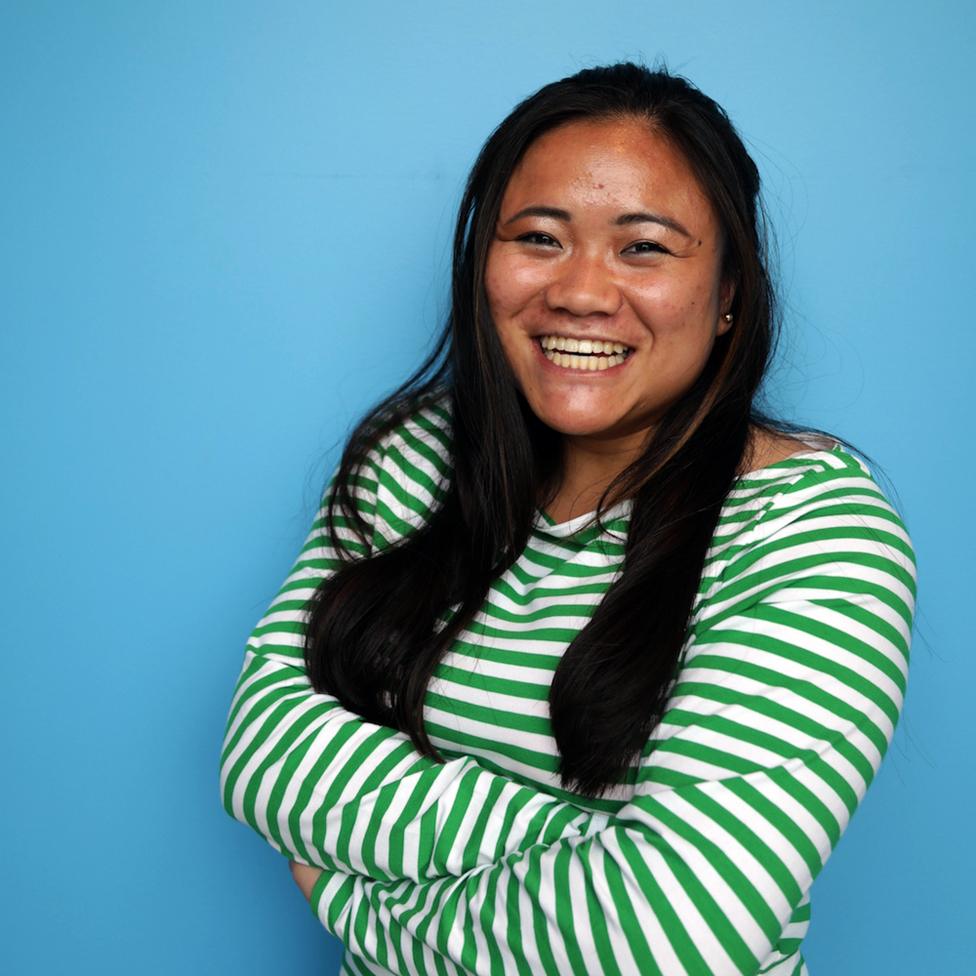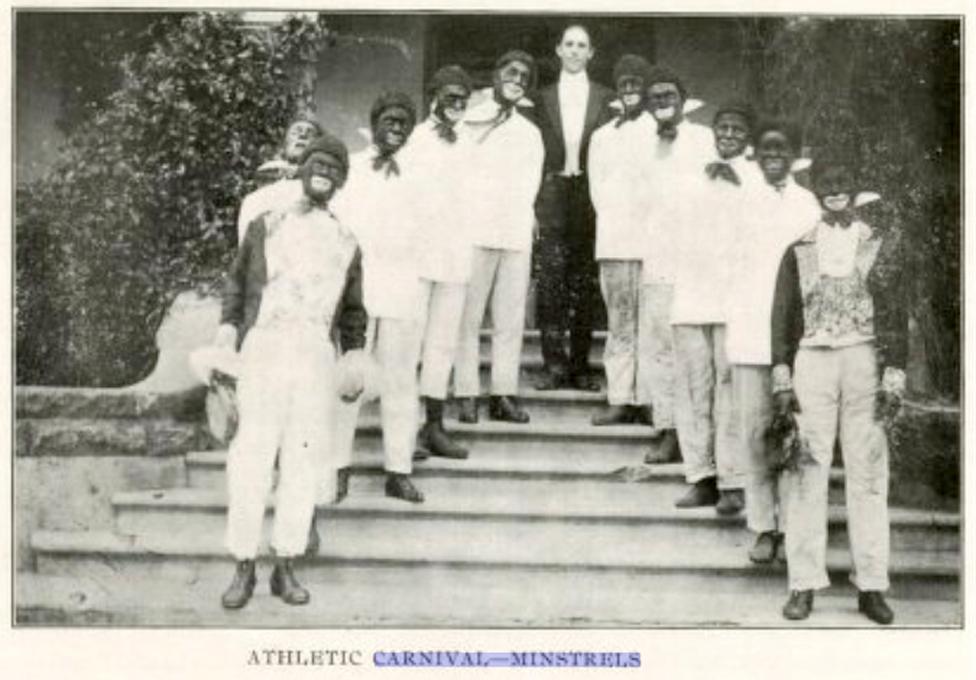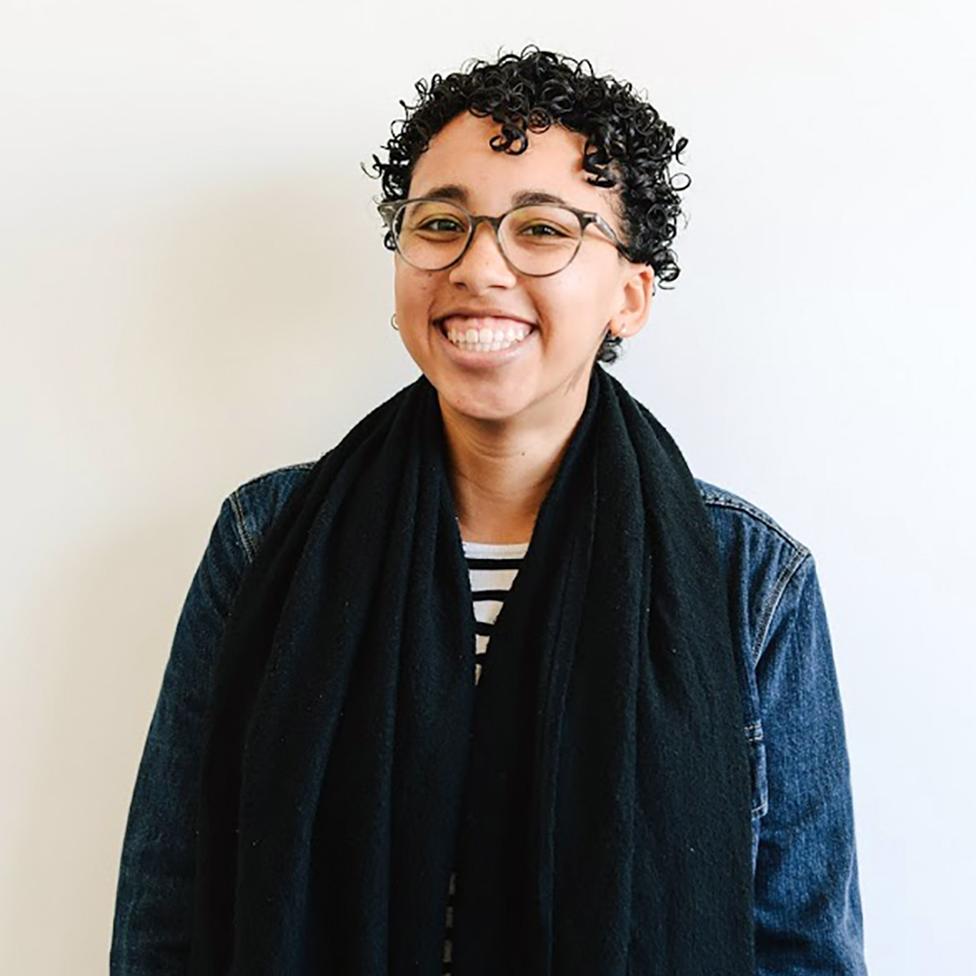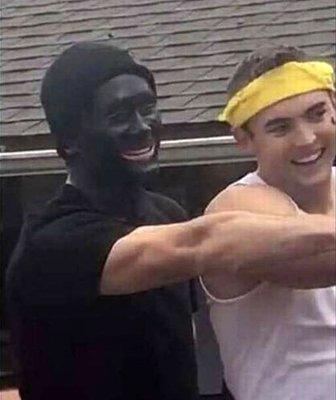'The blackface scandal that rocked my campus'
- Published

Members of the Lambda Chi Alpha fraternity posing as Mexican gangsters
A photo of a student partying in blackface caused days of tension on the campus of Cal Poly in San Luis Obispo, California. Protests erupted, the university authorities walked a tightrope defending free speech, and racist graffiti made an appearance. Student journalist Megan Schellong was in the thick of it and tells the story.
It's Monday 9 April 2018. All over campus students are talking about what's happened. The photograph of agricultural business student Kyler Watkins with his face painted black brought a quick apology from the fraternity - Lambda Chi Alpha - where the party took place.
Its statement says an event was held at which teams were represented by colour, with a student using blackface to show he was on the black team.
"We are extremely sorry and embarrassed for failing to recognise the racial impacts this brought forth," it says. "Although it was not our intention to stir up racial tensions, we understand the negative impact this picture had on our peers."
But then it turns out there is a second photograph, which shows other members of the fraternity posing as Mexican gangsters. They have racist anti-immigration messages scrawled on their arms as they flash fake gang signs, wearing baggy jeans, gold necklaces and bandanas.
As close to 400 protesters march through campus, I spot a small group of onlookers jeering from the sidelines. They don't want to be named, but one tells me that the protest is out of proportion. He says Kyler Watkins should not be punished: "It wasn't like he did it on purpose and posted stuff about it to offend people. It was just a personal choice, like he was drinking at a party, you know."

Find out more

Listen to Megan Schellong on Blackface on Campus, at 20:00 on Monday 26 November on BBC Radio 4

There are 19 fraternities at Cal Poly and 17 sororities, their female equivalent, all with names drawn from the Greek alphabet. About a quarter of students are members. The Lambda Chi Alpha house sits in a sprawling complex stretching back from the street. Its name is chiselled into a concrete slab that stands at the foot of the drive, next to the American flag, but today a blue sheet of tarpaulin covers the sign and the house appears to be in lock-down. The university and the national Lambda Chi Alpha organisation have put the campus chapter of the fraternity on "probationary suspension", limiting its activities.
I livestream a packed student meeting in the evening, where there are calls for Kyler Watkins to be expelled. A black student, Erica Green, says the photos offer proof that she's not welcome on her own campus. "When I see that picture, it is kind of hard when all your life you're told that your skin is ugly, you know, you look dirty. The more I think about it, it doesn't make me feel that this campus wants people like me here." She wants members of the fraternity to be ordered to complete a community service project in a minority community, "so they honestly understand what it's like for them".

One thing you should know about Cal Poly is that out of 22,000 students only 166 are black - a tiny fraction. There are more students like me from from an Asian background - I was adopted as an infant from an orphanage in China and grew up in Connecticut before moving out to California for college. However, I have awareness of what it is like to sit slightly at odds with the mainstream.
Monique Ejenuko, whose parents are from Nigeria, tells me that in her year only about 40 other students are black, a fact that really hit home on her first day. "I just looked around and I was the only drop of blackness in that whole auditorium and I almost cried," she tells me. "I was like - 'Oh my god, this is overwhelming. I just felt so alone."
I talk to Prof Elizabeth Sine about the history of blackface. She sees it as part of a racist tradition dating back to the minstrel shows of the 19th and early 20th Centuries.

Minstrel performers from Cal Poly's 1915 yearbook
White comedians would wear black face paint and caricature black people as lazy and ignorant, giving rise to the stereotype of the "happy-go-lucky darky on the plantation", or the "dandified coon". Blackface minstrel shows were, she says, a way of cementing a culture of white supremacy and racial hierarchy.
In an apology to the student newspaper, the Mustang News, Kyler Watkins says his action had nothing to do with "racism and discrimination" and that he was unaware of this history. "When I woke up Sunday morning to learn that 'blackface' is of historical racial significance, no words can express my regret and horror."
Soon, on the internet, I read about another scandal at Syracuse University in New York, where a fraternity has been suspended for a racist video showing members imitating sex acts and using racial slurs for black, Jewish and Hispanic people. Members are asked to pledge to always have hatred in their hearts for "African-Americans, Hispanics and Jews". One person in the video tells Jews to "get in the shower" - a reference to the gas chambers.
Prof Sine feels that today's polarised political landscape may explain why racist outbreaks are in the headlines again.

The next day, the organiser of Monday's student meeting, ethnic studies student Leilani Hemmings Pallay, is verbally abused as she stands, megaphone in hand, on the campus lawn.
"He was a tall white male and he walked up to me and yelled the N-word in my face. He then continued walking as if nothing had happened," she says. "A lot of the work that I do here on campus puts a target on me, but I was shocked that it happened then and that this person had the audacity to say that."

Leilani Hemmings Pallay
And the protests and counterprotests continue.
At one point, flyers are posted in the corridors of the agribusiness department claiming that black people are a sub-species - racially inferior to Caucasians. Some show maps of the globe connecting skin tones to IQ and to incidents of rape and homicide.
On Thursday, Prof Jeffrey Armstrong, the president of Cal Poly, holds an open forum, drawing a crowd of about 1,000 students. He condemns the blackface incident, but says it would not be right to expel Kyler Watkins. "That's very likely protected by free speech and freedom of expression," he says. "If a student walks around on campus with their face painted black, they can do that."

The Instagram picture that caused the outcry
He refuses my request for an interview, as does the head of the university office of diversity and inclusion, but Prof Brian Kennelly from the department of world languages and cultures agrees. This is how our conversation goes. First I ask, does he believe that Kyler Watkins should have been expelled?
I don't.
Why is that?
He didn't do anything illegal.
Even though he did something that harmed so many students on this campus?
He didn't do anything illegal.
And that's… is that the only reason?
That would be a reason not to expel him.
We then discuss his support for the idea of inviting the polemicist Milo Yiannopoulos to speak on campus, despite Yiannopoulos's links to white supremacists and the decision by Twitter to close his account because of his racist and sexist slurs.
Why do you think that words that are hateful should be allowed?
I'm a strong believer that speech should never be censored.
Even if it's hateful and could hurt…
Absolutely, despite that. And that's the tricky situation in which we find ourselves in the United States. The most abhorrent speech, the most hateful speech is still speech that needs to be protected.
Why do you believe that?
It's in the constitution.

On Tuesday 17 April, nine days after the photographs emerged, the university announces the suspension of all fraternities and sororities, citing not only the blackface photo, but another racially insensitive photo taken at a Sigma Nu fraternity event some weeks earlier, and also other racially charged events, sexual assaults and alcohol-related deaths over the past few years.
The same day, the N-word was written in a bathroom in the agribusiness department, and posters about the importance of diversity were slashed with a knife.

Seven months later a new academic year is under way. All new students attended a new mandatory diversity session during their welcome week. The suspension of the fraternities and sororities has been lifted.
But none of us who witnessed the events of last spring have forgotten them. I remember a silent protest on 14 April when everyone wore black, some with tape over their mouths. It was empowering. I got the chills. I wanted to cry. I got goosebumps, the hairs were literally sticking up on my skin. Never in my four years at Cal Poly have I witnessed the extent of solidarity among a group of individuals who will not stand for human indecency and racism.

But also that day a group of about 50 African American schoolchildren walked past with their parents and teachers. They were from a network of public charter schools that focuses on closing the African American achievement gap. Cal Poly's science and maths faculties have helped design the schools' coursework and campus tours take place regularly to help remind the youngsters of their education goals.
"That's the long game," said Margaret Fortune, the woman overseeing the schools. "It may not get as much press as a frat boy in blackface, but it's what the campus is doing because they recognise that diversity is important, and I hope that doesn't get lost."
Join the conversation - find us on Facebook, external, Instagram, external, YouTube, external and Twitter, external.
